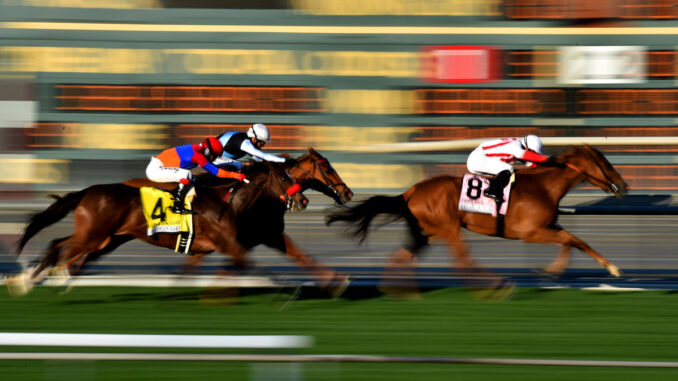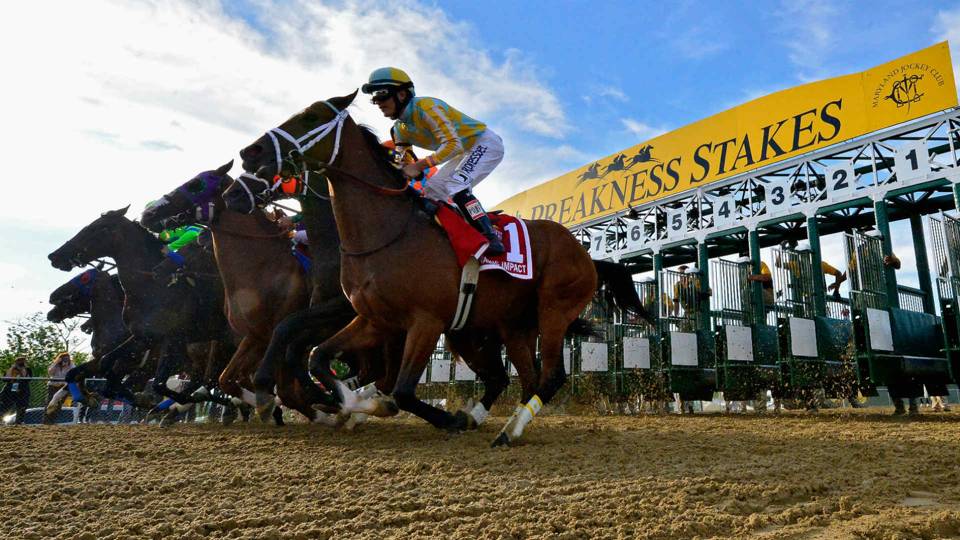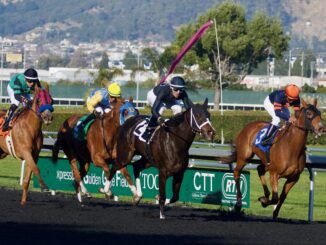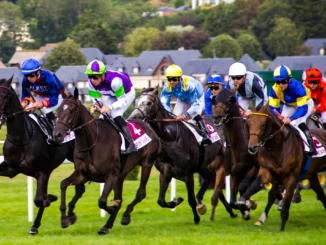
Horse racing occurs once a year in Kentucky and lasts about 90 seconds, at least as far as most Americans outside of Kentucky are concerned. But horse racing is a legitimate sport for people so addicted to it that they can’t stop riding horses or, more commonly, frequent the facilities where the competitions transpire and get all excited about the outcome for some reason.
In fact, one of the best tennis coaches of all time – at least within the Tacoma City Limits and more specifically within the property lines of the world-renown Tacoma Lawn Tennis Club – turned out to be so committed to horse racing that (rumor had it) he hit the track every Tuesday. And, as it turns out, the 49 other days between May 19th and September 23rd encompassed the live racing season at Emerald Downs, the local gambling empire or, that is, horse racing track.
This real but not-to-be-named great coach played tennis with wisdom and vigor that belied his age, which may have been 37 or so at the time. Which is obviously kind of old for a top-performing athlete to still top perform, although – thanks to extreme advances in plastic surgery, the invention of hypobaric chambers, and the increasing popularity of inversion therapy where one hangs upside down from one’s feet with the help of a contraption built specifically to hang humans upside down from their feet, which is interesting for therapeutic purposes considering it used to be a way to torture people during the Inquisition, most likely – is no longer uncommon as evidenced by the rampant success of Raphael Nadal who is now 68 years old, and that other good-looking guy, ol’ what’s his name…oh, Roger Federer, also 68.
And Novak Djokovic, however no one really wants to talk about him because he looks like a super villain.
But this story takes place roughly 30 years ago when the most popular anti-aging treatments still involved SunIn® for regular people, hot oil hair treatments for rich people, and most notably, the first use of Botox or botulinum toxin, also for rich people. That’s how progress is measured: Rich people turning one of the most poisonous biological substances known to humankind into a beauty product.
Botox paralysis muscles but somehow gets rid of wrinkles, and actually led to the official Worldwide Shortage of Botox in 1997 where women in L.A. County took to armed but very well-dressed robbery of liquor stores for untraceable cash with which to buy slightly less-effective, knock-off bacteria from unscrupulous dealers, specifically lactobacillus delbrueckii subspecies bulgaricus, which is one of the main bacterium used in the production of delicious yogurt, and thus resulted in furthering the pent-up, competitive, insecure rage of these women as their faces simply melted into deep crevasses of wrinkles as the yogurt possessed absolutely no ability to make their faces immovable, shiny masks.
Yet yogurt usage, ironically, made them more appealing to their target audience of wealthy investment bankers since they no longer looked like expressionless K-Mart mannequins. And, even more ironically, birthed the modern yogurt face cream industry given the inherent lactic acid dissolves dead skin cells and what’s more serves as an all-around beauty multi-tasker as it (the yogurt) moisturizes, fights acne, prevents premature aging (a term which actually has no definition), relieves sunburn and reduces discoloration, according to the yogurt beauty product manufacturing industry at least.
Nonetheless, our storied 90’s era coach of approximately 37 years coached pretty well, used to play up to the satellite tennis tournament level pretty well, and loved Trifectas.
In professional tennis, satellite circuits were four-week tournaments for players outside the top few hundred ATP rankings where they, if successful, could move on to top-flight ATP Tour events. It’s the tennis tournament version of, “So you’re saying there’s a chance” for folks looking to go pro. Nowadays, it goes by the ITF World Tennis Tour, representing the lowest rung of the professional tennis ladder. Nearly every professional player has spent time on the ITF World Tennis Tour.
This brings up another story about another best, highly-localized tennis coach of all time who was a great athlete and used to walk into the Tacoma Lawn Tennis Club-hosted PNW Open – the largest tennis tournament in the Pacific Northwest with $50,000 in prize money at stake (singles champions earn somewhere in the neighborhood of four grand), and a tournament that in 2017 chose to close the gender wage gap by awarding equal prize money to both men and women which is just insane to think it took that long and reflect upon all the years where the women got paid less based on the fact they are women – with his shirt off. That’s just awesome.
Anyway, this shirtless, ripped coach borrowed a bunch of money from club members to hit the satellite circuit where he didn’t find success and ended up not paying any of it back and getting a job installing those steel mesh cages/bulletproof partitions in cop cars that separate the back seat from the front. To prevent attacks and shootings and stabbings and such. This shows how hard it is to go pro as a great tennis player or a cop.
It turns out horse racing is a hot-button issue for many folks, particularly PETA, but it’s currently still a sport, as evidenced by the following realities:
- Jockeys endure regular fitness regimens like any pro athlete with the added pressure of maintaining full control of their diet as horses are allocated a specific weight to carry in a race. Jockeys weigh on average between 108-118 pounds and lead 1200-pound horses upwards of 40 miles per hour, so it’s not just about being lightweight; it’s about balancing the weight with strength like a gymnast. Dang!
Update: A gymnast we know stated, “They are holding a contraction in their quads, hamstrings, and glutes for the duration of the race, while the horse is going 40 mph. Not even a gymnast can do that.”
- Horses’ enormous aerobic capacity allowed various ancient warriors like the one we reported on in high school, Alexander the Great (and his horse Bucephalus), to range thousands of miles and subjugate those populations without horses or contemporary weapons technology or leaders with cool names. The point is, despite their innate desire to avoid danger, horses’ intense competitive spirit melds with skilled, horse-whispering type training to create a pretty awesome, albeit non-human, athlete.
- A session bringing the horse to a fast gallop to test its speed and fitness is called a work or breeze. The workouts can be timed by a clocker and are permitted to be published in industry papers and track programs. It allows potential buyers and people placing wagers to see how the horse has been performing up to a race. This brings up some interesting points…
1. Much like what happened with the FBI investigation into college basketball corruption in 2017 (Missed that? Don’t worry everyone did) or on a more lighthearted (sort of) note the whole Deflate-Gate thing, federal investigators have used surveillance to determine the catch people putting Performance Enhancing Drugs (PED’s) in horses. For example, in 2020, the trainer of the world’s best thoroughbred racehorse was indicted on federal charges for participation in a doping scheme.
2. So like all the sports we love (think Major League Baseball currently enforcing rules around pitchers cheating by using “sticky balls”), there are some unsavory characters involved in horse racing, including corrupt “coaches” and ownership, low-level hustlers, and gambling enterprises attempting to influence the outcomes. But it’s really no different than any other sporting situation.
Ultimately horse racing is a social activity that draws people who enjoy the communal aspect of watching races. It’s essentially a day-long social event punctuated by exciting races. Plus, there’s the whole fashion thing, what with the gigantic hats and other ridiculousness, a.k.a. the horse racing equivalent of face painting for a football or basketball game or waving those small country-sized flags at a soccer match.
If managed and led correctly, horse racing can be a great educator and encourage a sense of responsibility toward caring for animals and respecting the beauty and agility of the racehorse as an athlete. Making us better humans overall, in theory.
So hit the track. Do some (legal) wagering. Have a beer. Check out something you haven’t seen before. Life is short and complicated, but the horses don’t care, and the race is fairly simple, and we could all use more of that.




